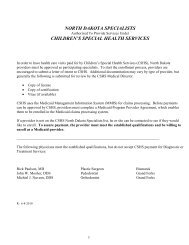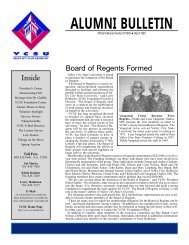Packaging, Loading the Freezer and Refreezing - NDSU
Packaging, Loading the Freezer and Refreezing - NDSU
Packaging, Loading the Freezer and Refreezing - NDSU
You also want an ePaper? Increase the reach of your titles
YUMPU automatically turns print PDFs into web optimized ePapers that Google loves.
FN-W614<br />
■ Introduction<br />
Food Freezing Basics:<br />
<strong>Packaging</strong>, <strong>Loading</strong> <strong>the</strong><br />
<strong>Freezer</strong> <strong>and</strong> <strong>Refreezing</strong><br />
Julie Garden-Robinson<br />
Food <strong>and</strong> Nutrition Specialist<br />
Freezing is one of <strong>the</strong> easiest, quickest, most versatile<br />
<strong>and</strong> most convenient methods of preserving foods.<br />
Properly frozen foods maintain more of <strong>the</strong>ir original<br />
color, flavor <strong>and</strong> texture <strong>and</strong> generally more of <strong>the</strong>ir<br />
nutrients than foods preserved by o<strong>the</strong>r methods.<br />
Good freezer management is important. The following<br />
tips will help you get <strong>the</strong> most of your freezer dollar.<br />
Place your freezer in a cool, dry area where <strong>the</strong><br />
temperature is constant.<br />
Keep your freezer at least ¾ full for efficient operation.<br />
Continue to use <strong>and</strong> replace foods. Do not simply<br />
store <strong>the</strong>m.<br />
Open <strong>the</strong> freezer door as rarely as possible.<br />
Make proper use of energy saving features on your<br />
freezer.<br />
Keep door seals clean <strong>and</strong> check for proper sealing.<br />
Replace when necessary.<br />
Defrost manual freezers regularly.<br />
Keep <strong>the</strong> condenser coils clean.<br />
North Dakota State University, Fargo, North Dakota 58105<br />
AUGUST 2005<br />
■ Factors Affecting Quality<br />
The condition of <strong>the</strong> food at <strong>the</strong> time of freezing will<br />
determine <strong>the</strong> final quality of <strong>the</strong> frozen food. Frozen food<br />
can be no better than <strong>the</strong> food was before it was frozen.<br />
Freezing does not sterilize foods as canning does.<br />
It simply retards <strong>the</strong> growth of microorganisms <strong>and</strong><br />
slows down chemical changes that affect quality or<br />
cause food spoilage.<br />
Enzymes<br />
Freezing, heating <strong>and</strong> chemical compounds can control<br />
enzyme actions. Freezing slows enzyme activity so that<br />
many frozen foods, such as meats <strong>and</strong> many fruits, will<br />
keep satisfactorily with little or no fur<strong>the</strong>r treatment.<br />
Enzymes in vegetables are inactivated by heat during <strong>the</strong><br />
recommended blanching process.<br />
Air<br />
Oxygen in <strong>the</strong> air may cause flavor <strong>and</strong> color changes<br />
if <strong>the</strong> food is improperly packaged.<br />
Microorganisms<br />
Microorganisms do not grow at freezer temperature, but<br />
most are not destroyed <strong>and</strong> will multiply as quickly as ever<br />
when <strong>the</strong> frozen food is thawed <strong>and</strong> allowed to st<strong>and</strong> at<br />
room temperature.<br />
Ice Crystals<br />
The formation of small ice crystals during freezing is<br />
desirable. Fast freezing is <strong>the</strong> most practical way to form<br />
small ice crystals. Large ice crystals associated with slow<br />
freezing tend to rupture <strong>the</strong> cells, causing an undesirable<br />
texture change.<br />
<strong>Freezer</strong> Temperature<br />
Maintain temperature of 0 degrees Fahrenheit or less to<br />
keep frozen foods at top quality. The storage life of foods<br />
is shortened as <strong>the</strong> temperature rises. For example, <strong>the</strong><br />
same loss of quality in frozen beans stored at 0 F for one<br />
year will occur in three months at 10 F, in three weeks at<br />
20 F, <strong>and</strong> in five days at 30 F.
Fluctuating temperatures result in growth in <strong>the</strong> size of ice<br />
crystals, fur<strong>the</strong>r damaging cells <strong>and</strong> creating a mushier<br />
product. Changes in temperature can also cause water to<br />
migrate from <strong>the</strong> product.<br />
Evaporation of Moisture<br />
Improperly protected food will lose moisture, color, flavor<br />
<strong>and</strong> texture. Ice crystal evaporation from an area at <strong>the</strong><br />
surface results in freezer burn, which is a dry, grainy,<br />
brownish area that becomes tough. <strong>Freezer</strong> burn does<br />
not render a food unsafe, only less desirable.<br />
■ <strong>Packaging</strong> Materials<br />
The prime purpose of packaging is to keep food from<br />
drying out <strong>and</strong> to preserve nutritive value, flavor, texture<br />
<strong>and</strong> color. Labels on packages will say if <strong>the</strong> product is<br />
suitable for freezer storage. A good packaging material<br />
should have <strong>the</strong> following characteristics:<br />
Moisture/vapor-proof or at least moisture resistant.<br />
Made of food grade material, i.e. designed to be used<br />
for food products.<br />
Durable <strong>and</strong> leakproof.<br />
Doesn’t become brittle <strong>and</strong> crack at low temperatures.<br />
Resistant to oil, grease or water.<br />
Protect foods from off flavors <strong>and</strong> odors.<br />
Easy to fill <strong>and</strong> seal.<br />
Easy to mark <strong>and</strong> store.<br />
The packaging you select will depend on <strong>the</strong> type of food<br />
to be frozen, personal preference <strong>and</strong> availability. For<br />
satisfactory results, do not freeze fruits <strong>and</strong> vegetables<br />
in containers larger than one-half gallon.<br />
<strong>Packaging</strong> not sufficiently moisture/vapor-resistant for<br />
long-time freezer storage includes ordinary waxed paper<br />
<strong>and</strong> paper cartons from ice cream <strong>and</strong> milk.<br />
Rigid Containers<br />
Rigid containers are made of plastic, glass, aluminum <strong>and</strong><br />
heavily waxed cardboard <strong>and</strong> are suitable for all packs.<br />
These are often reusable. Straight or tapered sides on<br />
rigid containers make it much easier to remove frozen<br />
foods.<br />
Glass jars used for freezing should be made for <strong>the</strong><br />
purpose. Regular glass jars may not withst<strong>and</strong> <strong>the</strong> extremes<br />
in temperature. Do not use regular, narrow-mouth<br />
canning jars for freezing foods packed in liquid. Expansion<br />
of <strong>the</strong> liquid could cause <strong>the</strong> jar to break at <strong>the</strong> neck.<br />
Cans, such as shortening <strong>and</strong> coffee cans, are good for<br />
packaging delicate foods. Line <strong>the</strong> can with a food-storage<br />
bag <strong>and</strong> seal <strong>the</strong> lid with freezer tape because <strong>the</strong>y are<br />
not airtight.<br />
Baking dishes can be used for freezing, heating <strong>and</strong><br />
serving. Dishes may be covered with a heavy aluminum<br />
foil taped with freezer tape. To reuse <strong>the</strong> baking dish<br />
after <strong>the</strong> food is frozen, wrap <strong>the</strong> food in casserolewrap<br />
fashion. (See “Food Freezing Basics: Methods of<br />
Wrapping.”)<br />
Ice cube trays are good for freezing foods in small<br />
amounts. Freeze food until firm <strong>and</strong> <strong>the</strong>n transfer to<br />
freezer bags.<br />
Flexible Bags or Wrapping<br />
Bags <strong>and</strong> sheets of moisture/vapor-resistant materials<br />
<strong>and</strong> heavy-duty foil are suitable for dry packed vegetables<br />
<strong>and</strong> fruits, meat, fish or poultry. Bags can also be used for<br />
liquid packs. Protective cardboard cartons may be used<br />
to protect bags <strong>and</strong> sheets from tearing <strong>and</strong> to make<br />
stacking easier.<br />
Laminated papers made of various combinations of paper,<br />
metal foil <strong>and</strong>/or cellophane are suitable for dry packed<br />
vegetables <strong>and</strong> fruits, meats, fish <strong>and</strong> poultry. Laminated<br />
papers are also used as protective overwrap.<br />
■ <strong>Packaging</strong>, Sealing <strong>and</strong> Labeling<br />
Cool all foods <strong>and</strong> syrup before packing. This speeds<br />
up freezing <strong>and</strong> helps retain natural color, flavor <strong>and</strong><br />
texture of food.<br />
Pack foods in quantities that will be used at one time.<br />
Most foods require head space between <strong>the</strong> packed<br />
food <strong>and</strong> <strong>the</strong> closure for expansion as <strong>the</strong> food freezes.<br />
Loose packing vegetables, such as asparagus <strong>and</strong><br />
broccoli, bony pieces of meat, tray-packed foods <strong>and</strong><br />
breads, do not need head space.<br />
Pack foods tightly to cut down on <strong>the</strong> amount of air in<br />
<strong>the</strong> package.<br />
Run a nonmetal utensil, such as a rubber scraper<br />
h<strong>and</strong>le, around <strong>the</strong> inside of <strong>the</strong> container to eliminate<br />
air pockets.<br />
When wrapping food, press out as much air as<br />
possible <strong>and</strong> mold <strong>the</strong> wrapping as close to <strong>the</strong> food<br />
as possible.<br />
When packing food in bags, press <strong>the</strong> air from <strong>the</strong><br />
bags. Beginning at <strong>the</strong> bottom of <strong>the</strong> bag, press firmly<br />
moving toward <strong>the</strong> top of <strong>the</strong> bag to prevent air from<br />
re-entering or force <strong>the</strong> air out by placing <strong>the</strong> filled bag<br />
in a bowl of cold water taking care that no water enters<br />
<strong>the</strong> bag. Seal ei<strong>the</strong>r method by twisting <strong>and</strong> folding<br />
back <strong>the</strong> top of <strong>the</strong> bag <strong>and</strong> securing with string, good<br />
quality rubber b<strong>and</strong>, strip of coated wire or o<strong>the</strong>r<br />
sealing device. Many bags may be heat sealed, <strong>and</strong><br />
some have a tongue-in-groove seal built in.<br />
Keep sealing edges free from moisture or food so<br />
<strong>the</strong>y’ll make a good closure.
When using tape, it should be freezer tape, designed<br />
for use in <strong>the</strong> freezer. The adhesive remains effective<br />
at low temperature.<br />
Label each package with name of product, date,<br />
amount <strong>and</strong> any added ingredients. Use freezer tape,<br />
freezer marking pens or crayons, or gummed labels<br />
made especially for freezer use.<br />
■ <strong>Loading</strong> <strong>the</strong> <strong>Freezer</strong><br />
Freeze foods at 0 F or lower. To facilitate more rapid<br />
freezing, set <strong>the</strong> freezer at minus 10 F about 24 hours<br />
in advance of adding unfrozen foods.<br />
Freeze foods as soon as <strong>the</strong>y are packaged <strong>and</strong><br />
sealed.<br />
Do not overload <strong>the</strong> freezer with unfrozen food. Add<br />
only <strong>the</strong> amount that will freeze within 24 hours. This is<br />
usually 2 or 3 pounds of food per cubic foot of storage<br />
space. Overloading slows down <strong>the</strong> freezing rate, <strong>and</strong><br />
foods that freeze too slowly may lose <strong>the</strong>ir quality.<br />
Place packages against freezing plates or coils. Leave<br />
space between packages so air can circulate freely.<br />
After freezing, store packages close toge<strong>the</strong>r.<br />
Arrange packages so you use those that have been in<br />
<strong>the</strong> freezer <strong>the</strong> longest first.<br />
■ <strong>Freezer</strong> Inventory<br />
Keep a list of all <strong>the</strong> foods in <strong>the</strong> freezer. Update <strong>the</strong><br />
list each time food you put food in or take it out of <strong>the</strong><br />
freezer. Use of an inventory can prevent overstorage of<br />
foods <strong>and</strong> loss of quality.<br />
■ Thawing Foods<br />
Most of <strong>the</strong> changes that appear during thawing are a<br />
result of freezing <strong>and</strong> storage. When food is thawed <strong>the</strong><br />
ice crystals melt, <strong>the</strong> liquid is ei<strong>the</strong>r absorbed back into<br />
<strong>the</strong> food or leaks out from <strong>the</strong> food. Slow, well-controlled<br />
thawing usually results in better return of moisture to<br />
<strong>the</strong> food <strong>and</strong> results in a food more like <strong>the</strong> original food<br />
than rapid thawing.<br />
Thawing in <strong>the</strong> refrigerator is <strong>the</strong> safest thawing method.<br />
Food st<strong>and</strong>ing at room temperature gives microorganisms<br />
<strong>the</strong> opportunity for growth <strong>and</strong> activity.<br />
■ What If <strong>the</strong> <strong>Freezer</strong> Stops?<br />
The basis for safety in refreezing foods is <strong>the</strong> temperature<br />
at which thawed foods have been held <strong>and</strong> <strong>the</strong> length of<br />
time <strong>the</strong>y were held after thawing. You can safely refreeze<br />
foods that still contain ice crystals or if <strong>the</strong>y are still cold,<br />
i.e. below 40 F, <strong>and</strong> have been held no longer than one or<br />
two days at this temperature after thawing. In general, if it<br />
is safe to eat it is safe to refreeze.<br />
Unfortunately, you often don’t know <strong>the</strong> time <strong>and</strong><br />
temperature. In <strong>the</strong>se cases, you need to consider <strong>the</strong><br />
following points.<br />
Do not open <strong>the</strong> door to check items; make a plan first.<br />
Try to determine, if possible, when <strong>the</strong> freezer may<br />
have stopped working.<br />
- Food in a closed, fully loaded freezer will keep for<br />
two days.<br />
- Food in a closed less than half loaded freezer won’t<br />
keep longer than one day.<br />
- Meat, because of density, will remain frozen longer<br />
than baked goods.<br />
- Foods in a larger, well-stocked freezer, will stay<br />
frozen longer.<br />
If <strong>the</strong> freezer will not be operational within a day or two:<br />
Use dry ice if available. Twenty-five pounds of dry ice<br />
in a 10 cubic foot freezer should hold <strong>the</strong> temperature<br />
below freezing for two to three days with less than<br />
half a load <strong>and</strong> three to four days in a fully loaded<br />
cabinet if you obtain dry ice quickly following<br />
interruption of freezer operation.<br />
Place dry ice on boards or heavy cardboard on top of<br />
packages. Open freezer only when necessary. Don’t<br />
h<strong>and</strong>le dry ice with bare h<strong>and</strong>s as it will cause burns.<br />
When using dry ice be sure <strong>the</strong> room is ventilated.<br />
If dry ice is not available, o<strong>the</strong>r options are to:<br />
- Cover <strong>the</strong> freezer with layers of newspaper <strong>and</strong><br />
blankets. Pin <strong>the</strong> blankets away from <strong>the</strong> air vent. The<br />
air vent must be open because <strong>the</strong> freezer needs air<br />
when electricity comes on. A blanket cover will help<br />
even when using dry ice.<br />
- Find o<strong>the</strong>r freezer storage at a locker plant or with<br />
friends <strong>and</strong> neighbors. Transfer foods in insulated<br />
boxes or well-wrapped in layers of newspapers.<br />
■ <strong>Refreezing</strong><br />
<strong>Refreezing</strong> needs to be done quickly. Clean <strong>the</strong> freezer<br />
before refilling. If <strong>the</strong> freezer has an adjustable temperature<br />
control, turn it to <strong>the</strong> coldest position.<br />
Check each package or container of food. You often can<br />
check nonrigid containers without opening by squeezing<br />
to feel for ice crystals. If <strong>the</strong>y need to be opened <strong>the</strong>y<br />
should be carefully rewrapped.
Place <strong>the</strong> warmer packages against <strong>the</strong> refrigerated<br />
surface when possible, but leave space between<br />
packages for air circulation.<br />
The quality of refrozen foods is diminished.<br />
Label <strong>and</strong> use refrozen foods as soon as possible.<br />
■ What to Refreeze<br />
Foods that have defrosted have no remaining ice crystals.<br />
If defrosted foods have warmed above refrigerator temperature<br />
(40 F) <strong>the</strong>y should not be refrozen, except for<br />
very high acid foods, such as fruits.<br />
Many thawed foods, i.e. those still containing many ice<br />
crystals or a firm-to-hard core of ice in <strong>the</strong> center, may<br />
be safely refrozen.<br />
Any signs of spoilage, off-odors or color in any food<br />
indicate you should dispose of <strong>the</strong> food without tasting.<br />
Remember, however, that you can’t rely on appearance<br />
<strong>and</strong> odor. Some foods may look <strong>and</strong> smell fine, but if<br />
<strong>the</strong>y’ve been at room temperature too long, food poisoning<br />
bacteria may have multiplied enough to cause illness.<br />
Meats, such as beef, pork, veal, lamb <strong>and</strong> poultry can<br />
be refrozen when <strong>the</strong>y are still firm with ice crystals. Meat<br />
still safe to eat can be cooked <strong>and</strong> refrozen. Discard<br />
meats if <strong>the</strong>y have any signs of spoilage such as an<br />
off-color or off-odor.<br />
Fruits usually ferment when <strong>the</strong>y start to spoil, which will<br />
not make <strong>the</strong>m dangerous to eat but will spoil <strong>the</strong> flavor.<br />
Defrosted fruits that smell <strong>and</strong> taste good can be refrozen.<br />
Vegetables should be refrozen only if <strong>the</strong>y contain plenty<br />
of ice crystals.<br />
Shellfish, prepared foods or leftovers should not be<br />
refrozen if defrosted. If <strong>the</strong> condition of <strong>the</strong> food is poor<br />
or even questionable, get rid of it. It may be dangerous.<br />
Never refreeze melted ice cream, cream pies, eclairs or<br />
similar foods.<br />
Unfrosted cakes, uncooked fruit pies, breads <strong>and</strong> rolls<br />
can be refrozen.<br />
The investment in <strong>the</strong> foods in <strong>the</strong> freezer may be<br />
significant, but so are <strong>the</strong> benefits of serving safe foods.<br />
■ Foods That Do Not Freeze Well<br />
FLAVOR CHANGE<br />
Pepper, cloves, imitation vanilla, garlic (especially<br />
uncooked), sage <strong>and</strong> celery seasonings may become<br />
strong <strong>and</strong>/or bitter.<br />
Curry may develop a musty off-flavor.<br />
Onion changes flavor during freezing.<br />
Salt loses flavor <strong>and</strong> has <strong>the</strong> tendency to increase<br />
rancidity of any item containing fat.<br />
Add artificial sweeteners <strong>and</strong> salt substitutes at serving<br />
time to be on <strong>the</strong> safe side.<br />
TEXTURE CHANGE<br />
Cooked egg whites become tough <strong>and</strong> rubbery.<br />
Soft meringues toughen <strong>and</strong> shrink.<br />
Mayonnaise <strong>and</strong> cooked egg or cream-based salad<br />
dressings seperate when frozen alone.<br />
Milk sauces or wheat-flour thickened gravies may<br />
separate or curdle.<br />
Half-<strong>and</strong>-half, sour cream <strong>and</strong> cottage cheese separate<br />
<strong>and</strong> may become grainy <strong>and</strong> watery when frozen<br />
alone. Buttermilk <strong>and</strong> yogurt react similarly, but can be<br />
used for baking.<br />
Custard or cream fillings tend to separate <strong>and</strong> become<br />
lumpy <strong>and</strong> watery.<br />
Boiled or fluffy frostings made with egg whites become<br />
sticky <strong>and</strong> weep.<br />
Cooked pasta products lose texture <strong>and</strong> tend to taste<br />
rewarmed when frozen alone.<br />
Most gelatin dishes tend to weep when thawed.<br />
Cheese or crumb toppings become soggy.<br />
Fried foods, except french-fried potatoes <strong>and</strong> onion<br />
rings, lose crispness <strong>and</strong> become soggy.<br />
Lettuce, tomatoes, celery, cucumbers, parsley,<br />
radishes <strong>and</strong> similar high-water-content vegetables<br />
become limp <strong>and</strong> watery.<br />
Potatoes might darken <strong>and</strong> have a texture change<br />
when included in frozen soups <strong>and</strong> stews. New<br />
potatoes freeze better than older ones.<br />
Canned hams can become tough <strong>and</strong> watery.<br />
Stuffed poultry cannot be safely frozen.<br />
For more information about food preservation, contact your local office of <strong>the</strong><br />
<strong>NDSU</strong> Extension Service or visit our food preservation Web site: www.ag.ndsu.nodak.edu/food.htm<br />
<strong>NDSU</strong> Extension Service, North Dakota State University of Agriculture <strong>and</strong> Applied Science, <strong>and</strong> U.S. Department of Agriculture cooperating. Duane Hauck, director, Fargo, N.D.<br />
Distributed in fur<strong>the</strong>rance of <strong>the</strong> acts of Congress of May 8 <strong>and</strong> June 30, 1914. We offer our programs <strong>and</strong> facilities to all people regardless of race, color, national origin, religion,<br />
sex, disability, age, Vietnam era veterans status or sexual orientation; <strong>and</strong> are an equal opportunity employer. Web only-7-05<br />
This publication will be made available in alternative format, upon request to people with disabilities, (701) 231-7881.


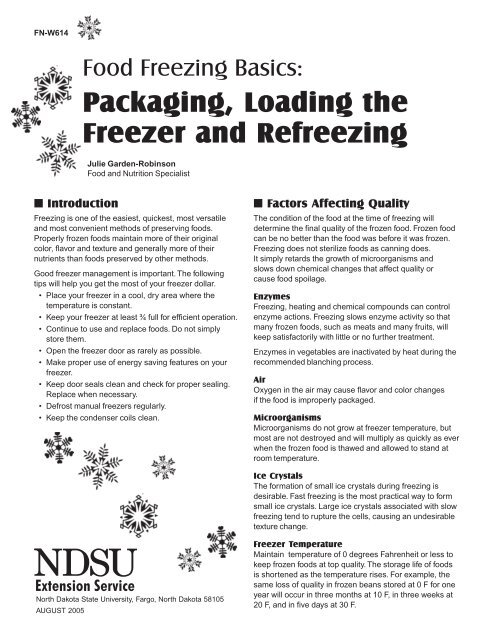
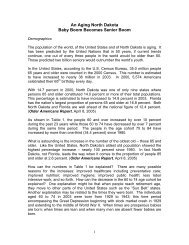


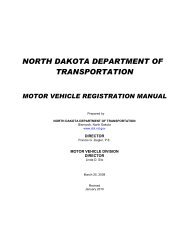
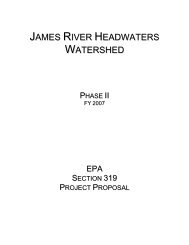

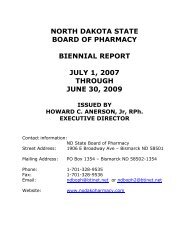
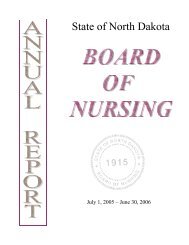

![T:\...\Wind Energy PanAer [PFP#1100138798] - North Dakota State ...](https://img.yumpu.com/17808731/1/190x245/twind-energy-panaer-pfp1100138798-north-dakota-state-.jpg?quality=85)
